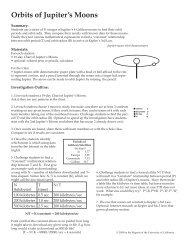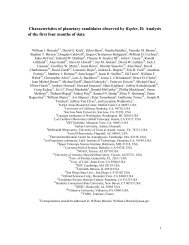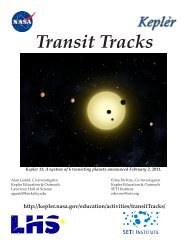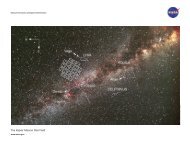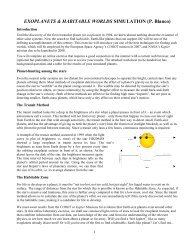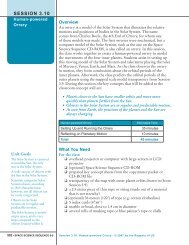POSTER ABSTRACTSP0403. POSTER SESSION ITHERMAL EVOLUTION AND MASS LOSS OF WATER-RICH SUPER-EARTHS. K. Kurosaki 1 , M. Ikoma1 , Y. Hori 2 and S. Ida 1 1 Department of Earth and Planetary Sciences, Tokyo Institute of Technology, Ookayama,Meguro-ku, Tokyo 152-8551, Japan; kurosaki@geo.titech.ac.jp (K. K.), mikoma@geo.titech.ac.jp (M. I.),ida@geo.titech.ac.jp (S. I.). 2 Division of Theoretical Astronomy, National Astronomical Observatory of Japan,Osawa, Mitaka, Tokyo, 181-8588, Japan; yasunori.hori@geo.titech.ac.jp .Introduction: Recent progresses in transit photometry—especially,operation of the two space-basedtelescope <strong>Kepler</strong> and CoRoT—have enabled us to findrelatively small short-period exoplanets with radii of afew to several Earth radii. Combined with planerarymasses measured by radial-velocity or transit-timingvariationmethods, many of the planets and planetarycandidates are inferred to be water-rich objects likeUranus and Neptune. Such objects are often called hotNeprunes. The radii of hot Neptunes are relatively sensitiveto their thermal and gravitational energy. Thus,understanding the distribution of hot Neptunes in themass-radius (or bulk density) diagram gives us greatinsights into the formation and evolution of the planetswhich include the histories of accretion, impact/erosion,and loss of energy and mass.Similarly to gas giants, water-dominanted planetsare born big in size. Then they shrink or become denserlosing their accrerion energy into space. Furthermore,since transiting planets orbit close to their hoststars, they experience mass loss driven by intense stellarX-ray and UV irradiation (XUV). Thus, interestingquestions are how large is the maximum radius (or theminimum bulk density) of a hot Neptune of a givenmass that we observe and how large is the minimummass of a hot Neptune that survives the mass loss.Previously, the thermal evolution and mass loss ofhot-Jupiters were investigated [1,2]. The mass andradius relationships of water-rich planets were calculatedfor relatively wide ranges of intrinsic and equilibriumtemperatures by Rogers et al. (2011) and Valenciaet al. (2010); they also estimated the possibleamounts of mass loss [3,4]. However, to ourknowledge, there is no study that simulates the thermalevolution and mass loss of water-rich planets concurrently.Methods: In this study, we have simulated thespherically symmetric structure and thermal evolutionof planets that are composed mainly of water. Themass loss is assumed to be due to stellar XUV irradiation;the mass loss rate is calculated, based on theoryof the energy limited hydrodynamic escape through theRoche lobe of the planet. The structure of the atmosphereis integrated, following Guillot (2010) [5].Results: The planet gets cold and shrinks by emittingits intrinsic heat. Inside the planet, the boundarybetween the radiative and convective layers becomesdeeper and deeper. This controls the thermal evolution.On a timescale of 1-10 Gyr, the intrinsic temperaturedecreases to a few ten Kelvin. At that time, the radiiare several to ten Earth radii for 1-10 Earth-mass water-dominatedplanets, provided the mass loss is ignored.However, if the mass loss is included, the lowmassand large-radius planets evaporate completely.Since the stellar XUV declines and the planetary radiusbecomes small with time, we have found there are distinctthreshold masses beyond which the planet survivesthe evporation due to XUV irradiation from thehost star. While the threshold mass depends on severalproperties of the planet and the star, it is found to bearound 10 Earth masses.Conclusions: We have found that the thermal evolutionof water-rich planets has a significant impact ontheir radius and mass loss rate. Besides, there is thelower limit to the mass of the planet that survives themass loss due to XUV irradiation from the host starsfor 10 billion years. These results give constraints tothe distribution of water-rich super-Earths on the massradius(or bulk density) diagram.References: [1] Baraffe, I. et al. (2003) A&A, 402,701-712. [2] Yelle, R. (2004) Icarus, 170, 167-179.[3] Rogers, L. et al. (2011) ApJ, 738, 59. [4] Valencia,D. et al. (2010) A&A, 516, A20. [5]Guillot,T. (2010)A&A, 520, A27.1622011 <strong>Kepler</strong> Science Conference - <strong>NASA</strong> Ames Research Center
POSTER ABSTRACTSP0404. POSTER SESSION ITHE HABITABLE EXOPLANETS CATALOG: AN EXTENSIVE QUANTITATIVE ASSESSMENT OFTHE HABITABILITY OF EXOPLANETS. A. Méndez, Planetary Habitability Laboratory, University of PuertoRico at Arecibo, Arecibo, PR 00613 (abel.mendez@upr.edu).Introduction: There are many catalogs compilingand describing the nearly 700 exoplanets that havebeen confirmed such as the Extrasolar Planets Encyclopaedia(exoplanet.eu), the Exoplanet Data Explorer(exoplanets.org), and The Visual Exoplanet Catalogue(exoplanet.hanno-rein.de). New ground and orbitalobservations with telescopes, like <strong>Kepler</strong>, is helping toidentify and confirm hundreds or thousands of additionalexoplanets in the coming years. Catalogs aregetting quite large and is becoming more difficult tosort out those habitable exoplanets that are of specialinterest for the astrobiology field.The Habitable Exoplanets Catalog (HEC) is a newproject by the Planetary Habitability Laboratory (PHL)of the University of Puerto Rico at Arecibo to helpidentify, compare, and visualize habitable exoplanetsfrom current discoveries [1]. The HEC is using newdevelopments by the PHL on habitability metrics andclassifications like the Earth Similarity Index (ESI) [2],the Habitable Zones Distance (HZD), and comparisonswith Earth past and present to help quantify the habitabilityof exoplanets, including potential exomoons.Habitability Metrics: Habitability metrics can beused to assess and compare the potential for life ofexoplanets as a function of many stellar and planetaryproperties. They provide a system for their identification,ranking, prioritization of observations, and evenrecognize those probably even more habitable thanEarth itself. Most of these metrics requires stellar andplanetary properties that are already available for manyexoplanets but models can be used otherwise. Fourhabitability metrics were used as first assessments.Habitable Zones Distance (HZD). The HZD is ameasure of how far a planet is from the center of itsparent star habitable zone (HZ) in habitable zone units(HZU). Planets inside the HZ have HZD values between-1 to +1 HZU, with zero being the exact centerof the HZ. The negative and positive values correspondto locations closer and farther to the star, respectively.The HZD is a function of the star’s luminosity andtemperature, and the planet’s distance.Earth Similarity Index (ESI). The ESI or the "easyscale," measures how similar is a planet to Earth in ascale from zero to one, with one being identical [2].Planets with ESI values between 0.8 and 1.0 are classifiedas Earth-like because they potentially have a rockycomposition that is able to hold a terrestrial atmosphereunder temperate conditions. The ESI is a functionof the planet's radius, density, escape velocity, andsurface temperature.Global Primary Habitability (GPH). The GPH or"gp-hab," measures the surface suitability of a planetarybody for a global biosphere of primary producersin a scale from zero to one, with one being more habitable.The GPH is a function of the star's luminosity,temperature, age, and metallicity, and the planet's albedo,distance, mass and radius. It provides the mostcomplete evaluation of planetary habitability given theinformation we already know for many exoplanets.Standard Primary Habitability (SPH). The SPH or'sp-hab,' measures the thermal-water climate suitabilityof a planet for land primary producers in a scale fromzero to one, with one being more habitable [3]. It iscorrelated with the distribution of vegetation and netprimary productivity (NPP). The SPH is a function ofthe planet's surface temperature and relative humidity.The SPH was originally developed for terrestrial ecologyassessments but it was also extended for exoplanetsstudies.Conclusion: The HEC identifies, organizes, andvisualizes potential habitable exoplanets, includingexomoons, in new ways. All metrics focus on surfacehabitability and does no consider yet subsurface environments.They are limited to what we can measuretoday for exoplanets and assume that all the other requirementsof life are present. The GPH and the SPHmetrics are better indicators of habitability than theHZD and the ESI, but require more information aboutthe exoplanets. So far, there are two potential habitableexoplanets identified and ranked in the catalog andfourteen from <strong>Kepler</strong> candidates, but more are expectedin the near future.The HEC provides tools for both scientists and educatorsstudying the habitability of exoplanets. Wealso developed various media and web tools to helpunderstand and visualize the number, diversity, andcharacteristics of exoplanets. The HEC is an initiativeof the PHL at the UPR Arecibo with the collaborationof various international scientists and educators, and itwill be freely available on the PHL web site(phl.upr.edu) on December 5, 2011. We expect thatinput from scientists, educators, and the general publicwill help improve the catalog, and probably take it innew directions.References: [1] Méndez A. et al. (2011) The HabitableExoplanets Catalog (in preparation). [2] Schulze-Makuch D. et al. (2011) Astrobiology (in press).[3] Méndez A. (2010) AbSciCon 2010, 5483–5484.2011 <strong>Kepler</strong> Science Conference - <strong>NASA</strong> Ames Research Center 163



